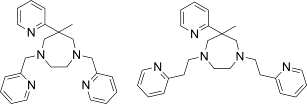Iron(II) Complexes of Two Amine/Imine N₅ Chelate Ligands Containing a 1,4-Diazepane Core – To Crossover or Not To Crossover

Abstract
Two new chelate ligands, 6-methyl-6-(pyridin-2-yl)-1,4-bis[(pyridin-2-yl)methyl]-1,4-diazepane (4a) and 6-methyl-6-(pyridin-2-yl)-1,4-bis[2-(pyridin-2-yl)ethyl]-1,4-diazepane (4b), were synthesized from pyridine-derived precursors in three-step procedures. Both ligands have N5 donor sets consisting of two tertiary amine and three pyridyl N atoms. Complexation with FeCl2 or FeBr2 in MeOH followed by anion exchange with (nBu4N)PF6 gave the complexes [Fe(4a)X]PF6 and [Fe(4b)X]PF6 (X = Cl, Br) in moderate-to-good yields. The coordination geometry around the iron(II) centre, as determined by single-crystal X-ray diffraction, is strongly distorted octahedral for ligand 4a and more regular for ligand 4b. Magnetic susceptibility measurements show the complexes to contain high-spin iron(II) over the whole range of temperatures (2 < T < 300 K). DFT calculations for the complexes of ligands 4a and 4b reproduce the high-spin ground state and suggest that exchange of the halide ligand for ligands that exhibit some degree of π-type interaction could induce SCO behaviour. Also, calculations of the zero-field splitting (ZFS) parameters of these complexes rationalize the observed sign change on the basis of different degrees of structural distortion imparted by ligands 4a and 4b.